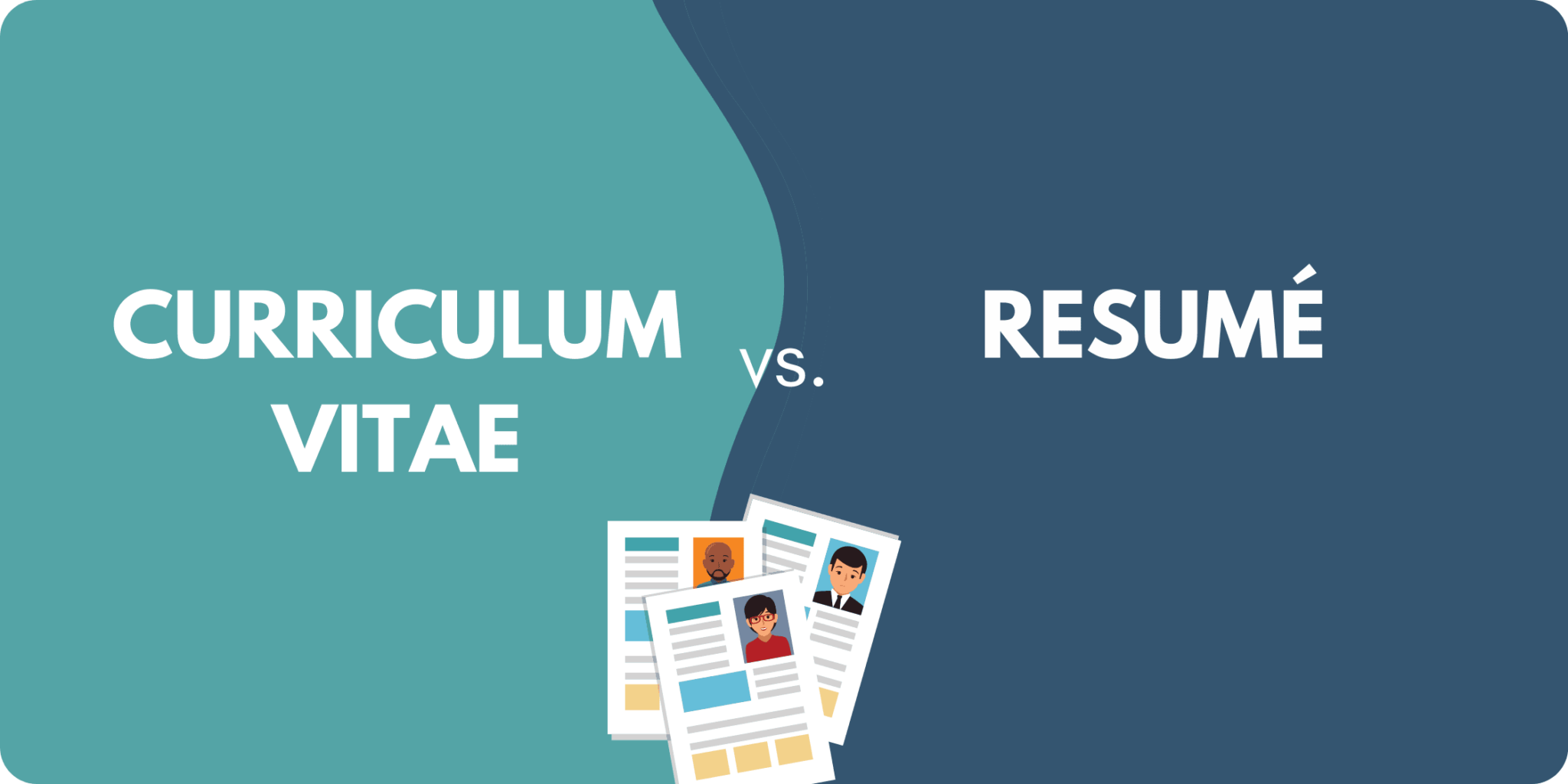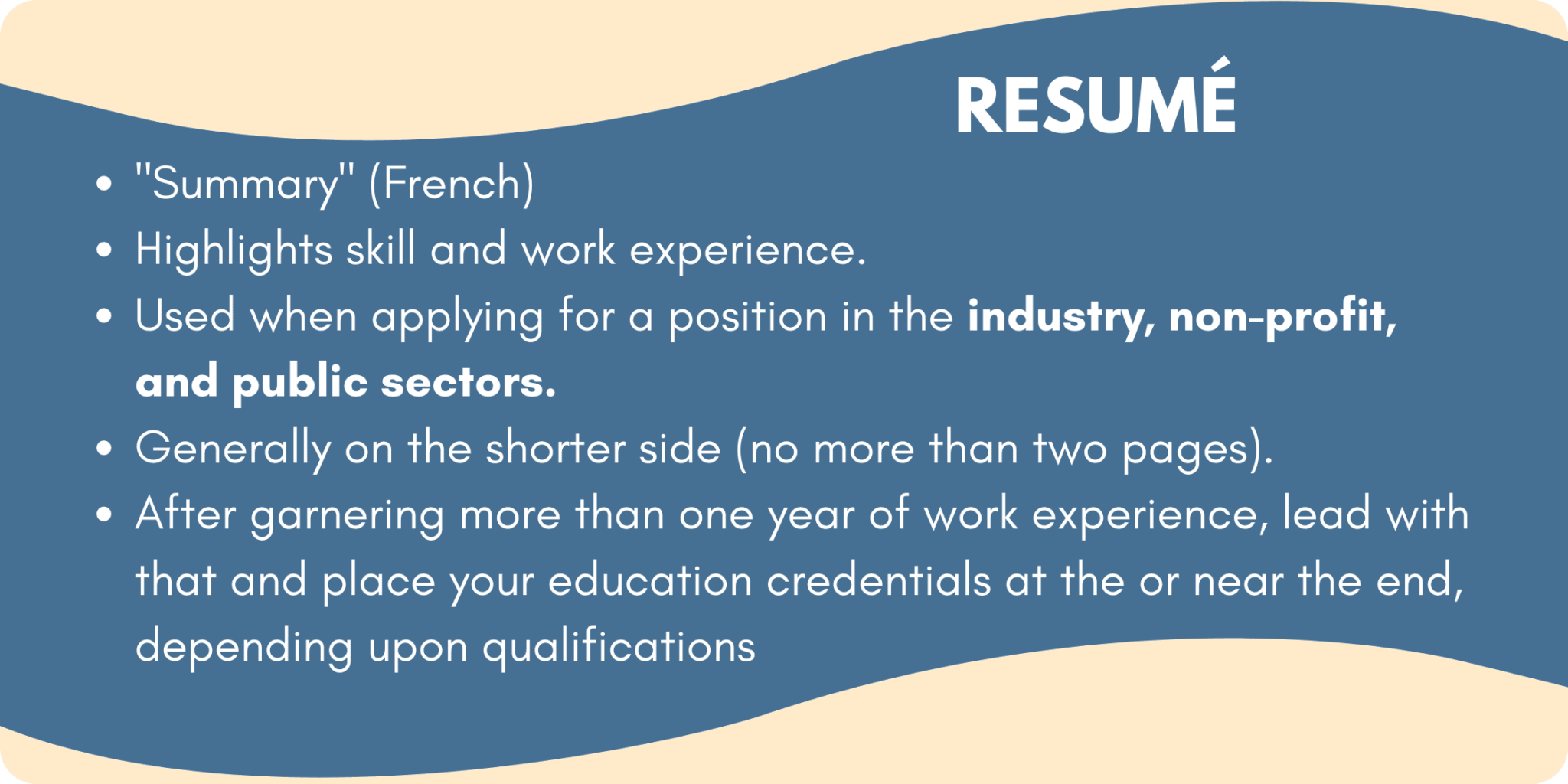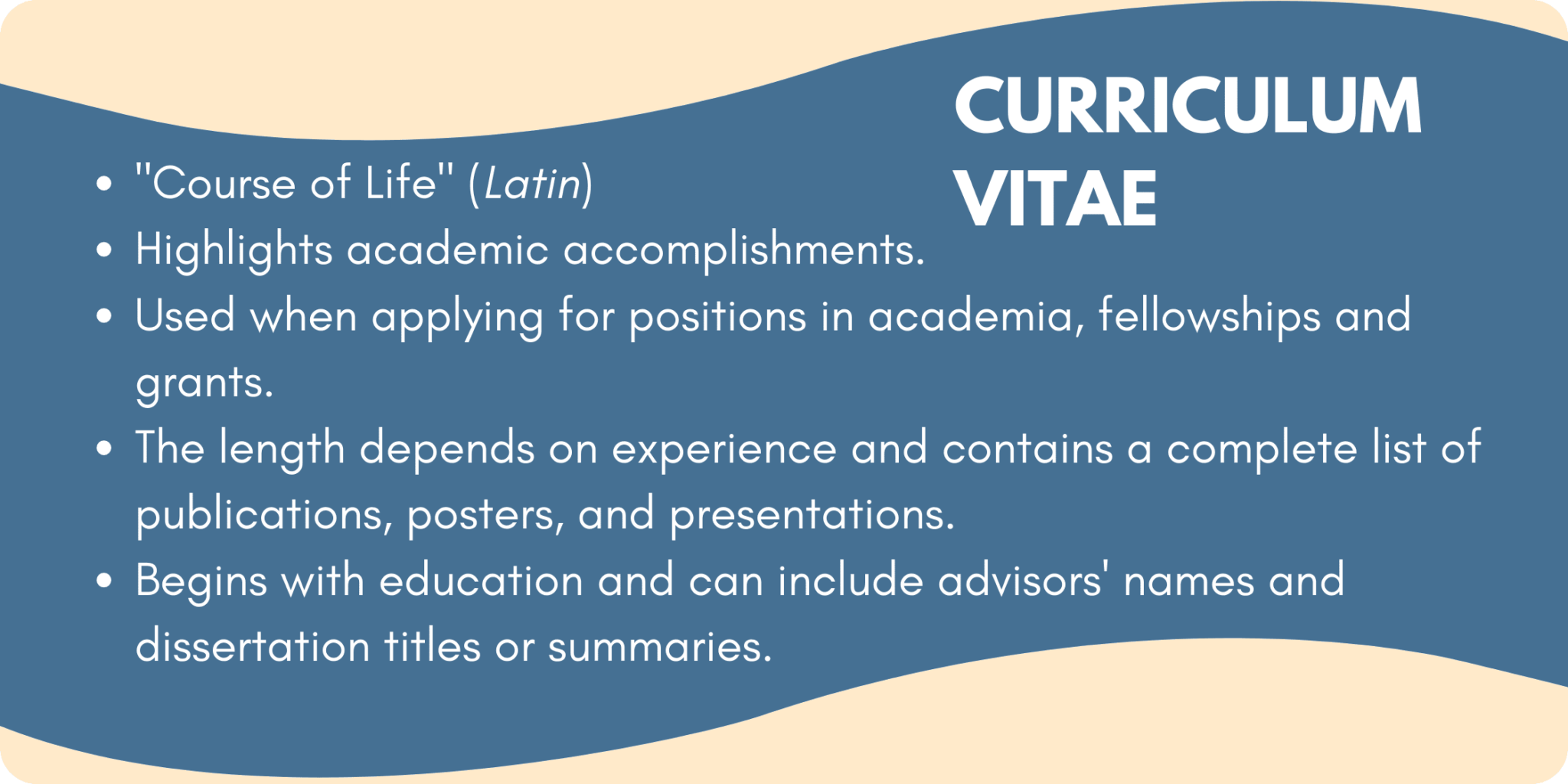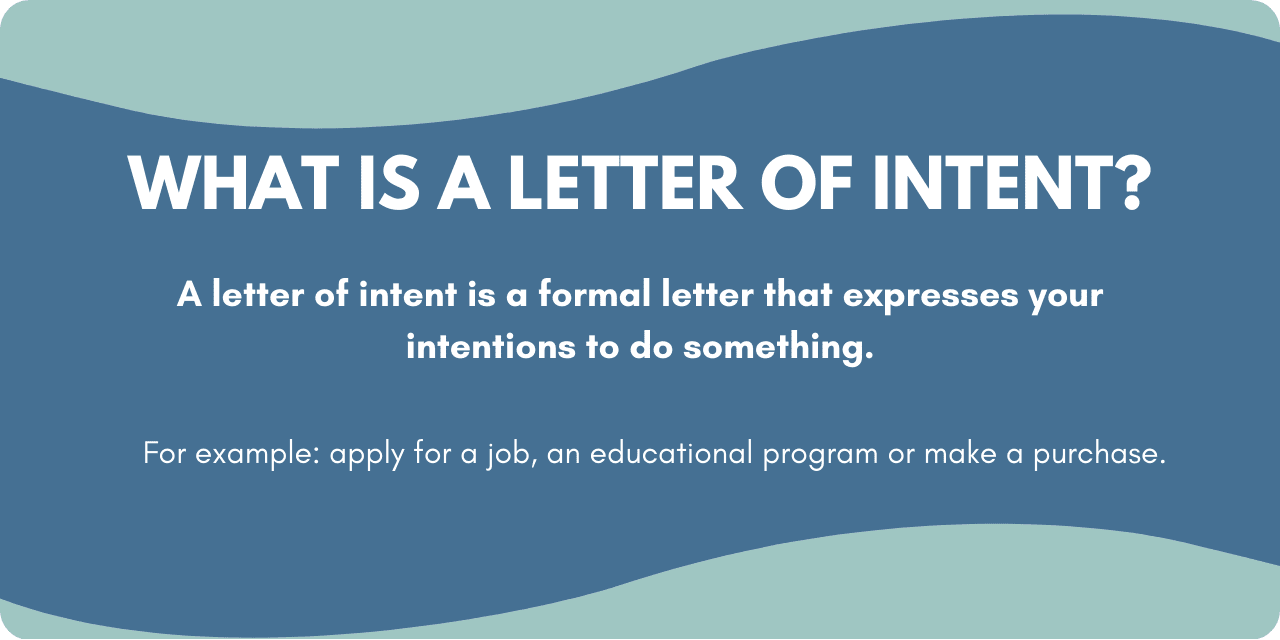
Let’s talk Curriculum Vitae vs Resume. When applying for a job, the terms curriculum vitae and resumé refer to documents that outline a job seeker’s skills so that the hiring managers can screen applicants based on their eligibility for the role.
Such a document is referred to as a resumé in North American English outside of academic circles and generally called a curriculum vitae, or CV for short, in other countries.
The difference between a CV and a resumé is slight, as a CV is a longer resumé detailing additional information relevant to the recruiter.
Here is brief rundown:
Resume:
- “Summary” (French)
- Highlights skills and work experience.
- Used when applying for a position in the industry, non-profit, and public sectors.
- Generally on the shorter side (no more than two pages).
- After garnering more than one year of work experience, lead with that and place your education credentials at the or near the end, depending upon qualifications
What Is a Resumé?

The word resumé is widely used in most parts of North America and Canada to refer to a document of 1-2 pages outlining an applicant’s current education, prior experiences, and skillset.
The word stems from the French “résumé,” which translates to “summary.”
There are two common types of resumés: the chronological resumé and the functional resumé. The former has withstood the test of time, having seen use in the U.S. and Canada for nearly 100 years.
On the other hand, the latter is more often used in niche-case scenarios and isn’t considered a standard layout for a resumé.
Chronological Resumé
More often than not, a chronological resumé is what most people envision when hearing the word resumé. The word chronological means “ordered by time,” so it is often used to create a list or provide information beginning with the oldest and working toward the newest, or vice versa.
This resumé features the most typical representation of a person’s skillset, outlined in a 1-2 page document that offers an in-depth look at an individual’s work experience and education in chronological order.
The design of this resumé type makes the reading easier for the hiring manager and is a good way for candidates to demonstrate their career growth.
A standard chronological resumé contains the following:
- A summary of the resumé
- Prior professional experience
- Education achievements
- A list of skills
In most cases, detailing prior work experience and education takes up the bulk of a resumé.
Functional Resumé
A functional resumé contains much the same information as a chronological one but portrays the applicant in the best light, exemplifying the expression, “Put your best foot forward.”
Candidates with a lot of job experience but haven’t attained a higher level of education may choose the functional resumé to highlight their skillset in the workplace.
Generally, a functional resumé consists of the following:
- Name and contact information
- A summary of skills and experiences
- Skill groupings
- Education
- Work experience
The difference between the two is that a functional resumé places a lot of emphasis on grouping skills together to emphasize the prospective hire’s interpersonal communication skills, commitment to detail, and strong work ethic.
What Is a Curriculum Vitae?

Curriculum vitae, Latin for “course of life,” is a detailed summary of an individual’s educational achievements, career positions, publications, notable projects, awards, honours and other accomplishments and qualifications.
Primarily used in academic circles, a curriculum vitae includes:
- All of the information outlined in a resumé while also detailing the applicant’s research interests.
- Any relevant awards or accolades they’ve received.
- Publications relating to their area of expertise.
- Professional affiliations and memberships.
This additional information helps hiring managers evaluate the skills and expertise of prospective hires.
Generally speaking, the curriculum vitae is mostly used for applicants seeking grants, fellowships, teaching/research positions, postdoctoral positions, etc. It is is therefore, as we stated earlier, much more prevalent in academia, medical fields and scientific research fields.
What’s the Difference between a Curriculum Vitae and Resumé?
If that description sounds remarkably similar to a resumé, it’s because they are highly similar. The term curriculum vitae, or CV for short, sees more use in academic circles and outside of the U.S., having a slight distinction from the term resumé.
Generally, in these cases, a curriculum vitae is more extensive than a resumé, consisting of the individual’s life work—publications, career positions, education, and other achievements—paired down into a 1-2 page document.
Often, these documents possess headings followed by relevant information and examples.
Here is a basic outline sample for a C.V.:
Name
EDUCATION
EXPERIENCE
- Research experience
- Teaching experience
- other relevant experience
SKILLS
CERTIFICATIONS
AWARDS and HONORS
PUBLICATIONS
PROFESSIONAL ORGANIZATIONS
GRANTS/SCHOLARSHIPS
In the United States, it is widely considered incorrect to refer to a “short CV,” as this would be a resumé, despite the recorded usage of the term curriculum vitae seeing historical use to encompass shorter summaries.
As such, the difference between the meaning of the words CV and resumé is mainly arbitrary, with only American academia and the medical field viewing a CV as a different term to describe a document featuring a more extensive overview of an individual’s achievements.
A short CV, for example, is usually the first bit of information an employer will receive from an applicant. If the hiring manager likes what they see, they may want to request a longer CV to screen the applicant further before an interview.
Again, the term curriculum vitae only means something different from resumé in academia and medical fields, where there is a need for extensive documentation on relevant achievements—publications, education, work experience—to confirm an applicant’s eligibility.
Outside of these two fields, the term CV and resumé are used interchangeably in America. In contrast, nearly all other English-speaking countries use the term CV to indicate a summary of job experience, employment history, and qualification.
In the European Union the two terms are generally used interchangeably. In other words, when applying for a position in Europe, and a CV is requested, it really means a resume, as the word CV is used to describe all job application documents.
Other Differences between a CV and a Resumé
In the U.S., there are a couple of different expectations when submitting a CV versus a resumé.
For example, a cover letter should accompany a resumé. This additional document is a brief letter outlining the applicant’s skills, enthusiasm to work for the company, and, on occasion, anecdotes detailing some of the experiences listed in their resumé.
A cover letter may begin like this:
“Dear Principal Housley,
I learned from your school website that your staff has an opening for an 8th-grade English teacher position. I want to express my interest in joining your team!
I recently graduated with my bachelor’s degree in Education, and teaching has been near and dear to my heart since my 8th-grade English teacher set me on a course to college by providing the motivation and encouragement I lacked during my early years in school.
During my time as a student teacher at City Junior High School, I learned that . . .”
A CV, by contrast, does not generally necessitate a cover letter. In an academic sense, a CV differs from a resumé in that one would include research interests, prestigious accolades, awards, and personal publications in their CV, but not necessarily in a resumé.
This information helps hiring managers to assess a candidate’s eligibility, especially for academic or medical occupations.
The Bottom Line
The difference between a CV and a resumé is very slight, the significant difference being that a CV is a longer resumé detailing additional information that may be relevant to the hiring manager.
A resumé generally follows a chronological order, while a CV may detail information differently and more at length.
The terms are used interchangeably outside academic circles in America, with all other English-speaking countries using the term CV. At the same time, American academia and medical fields distinguish between the two.
Leave a Reply
Website
Save my name, email, and website in this browser for the next time I comment.






